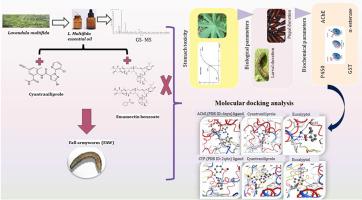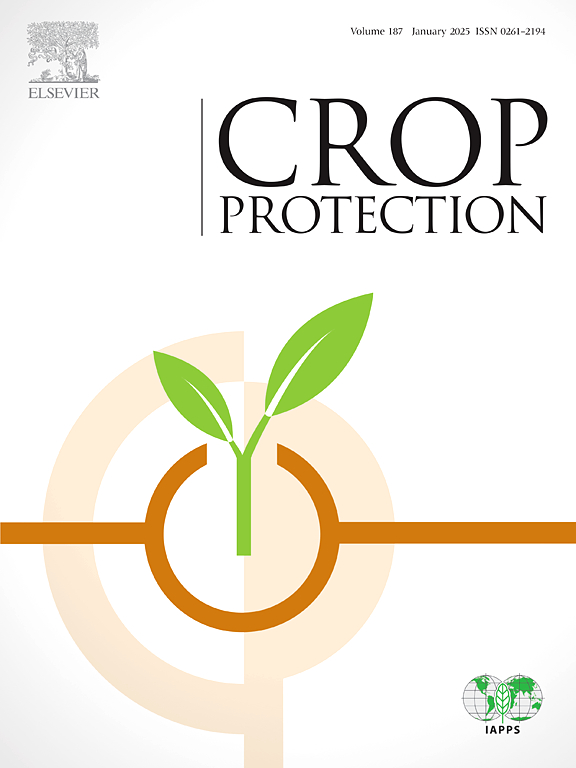多裂叶薰衣草精油及其与氰戊菊酯和苯甲酸阿维菌素二元组合对鞘翅目蚜虫(鳞翅目:夜蛾科)的体外和硅学杀虫特性探索
IF 2.5
2区 农林科学
Q1 AGRONOMY
引用次数: 0
摘要
在全球范围内,有效控制秋梢虫(FAW)(Spodoptera frugiperda)在各种作物上的传播和危害的控制方法面临着挑战,这凸显了对更具可持续性的综合方法的需求。本研究探讨了薰衣草(Lavandula multifida L.)精油(EO)、氰戊菊酯(CY)和苯甲酸阿维菌素(EM)杀虫剂对FAW幼虫的杀虫效果。通过毒性、生物和生化试验,阐明了这两种杀虫剂单独使用或与 LV EO 合用的影响。此外,还对桉叶油醇(LV EO 的主要成分)和 CY 与乙酰胆碱酯酶(AChE)(PDB ID:6xyu)和细胞色素 P450(PDB ID:2q6n)的分子对接进行了硅学研究。EM 是对一窝蜂幼虫毒性最大的化合物,半数致死浓度为 0.0073 毫克/升,其次是 CY 和 LV EO。秩方(χ2)检验证实了 LV EO/CY 组合的协同效应和 LV EO/EM 组合对草翅虫幼虫的拮抗作用。生物发育研究表明,LV EO/CY 和 LV EO/EM 组合都会影响幼虫和蛹的持续时间。生化试验表明,LV EO(LC25)、CY(LC25 & LC50)以及它们的二元组合(LC25:LC25)激活了 P450 特异性活性。此外,LV EO/CY 组合能显著激活 AChE 和 GST 的特异性活性,LV EO/CY 组合和 CY(LC50 时)能显著激活 α-酯酶的特异性活性。分子对接研究显示,桉叶油醇和 CY 的能量分数(S)分别为 -6.7729 和 -7.7644 kcal/mol,而 PDB ID: 6xyu 配体的能量分数(S)为 -7.0993 kcal/mol。目前的研究结果可作为在一窝蜂虫害综合防治(IPM)中使用 LV EO/CY 组合的基准数据。本文章由计算机程序翻译,如有差异,请以英文原文为准。

In vitro and Silico Exploration of the Insecticidal Properties of Lavandula multifida L. Essential Oil and its Binary Combinations with Cyantraniliprole and Emamectin benzoate on Spodoptera frugiperda (Lepidoptera: Noctuidae)
Control methods have faced challenges in effectively managing the spread and damage caused by the fall armyworm (FAW), Spodoptera frugiperda, across various crops worldwide, highlighting the need for more sustainable and integrated approaches. This study explored the insecticidal effect of the essential oil (EO) of lavender (LV) (Lavandula multifida L.), cyantraniliprole (CY), and emamectin benzoate (EM) insecticides on FAW larvae. Toxicity, biological, and biochemical assays were employed to elucidate the impact of the two insecticides individually or combined with LV EO. Additionally, in silico molecular docking investigations were performed for eucalyptol (the major component of LV EO) and for CY against the acetylcholine esterase (AChE) enzyme (PDB ID: 6xyu) and cytochrome P450 (PDB ID: 2q6n). EM was the most toxic compound to FAW larvae with an LC50 of 0.0073 mg L−1, followed by CY and LV EO. The chi-square (χ2) test confirmed the synergistic effect of the LV EO/CY combination and the antagonistic effect LV EO/EM combination on FAW larvae. Biological development studies revealed that both LV EO/CY and LV EO/EM combinations impacted the larval and pupal durations. The biochemical assays indicated that the P450-specific activity was activated by LV EO (at LC25), CY (at LC25 & LC50), and their binary combination (at LC25:LC25). In addition, the LV EO/CY combination significantly activated the AChE and GST-specific activity, and the LV EO/CY combination and CY (at LC50) significantly activated α-esterase- specific activity. Molecular docking investigations revealed energy scores (S) of −6.7729 and −7.7644 kcal/mol for eucalyptol and CY, compared to −7.0993 kcal/mol for PDB ID: 6xyu ligand. The current results can serve as baseline data for utilizing the LV EO/CY combination in the integrated pest management (IPM) of FAW.
求助全文
通过发布文献求助,成功后即可免费获取论文全文。
去求助
来源期刊

Crop Protection
农林科学-农艺学
CiteScore
6.10
自引率
3.60%
发文量
200
审稿时长
29 days
期刊介绍:
The Editors of Crop Protection especially welcome papers describing an interdisciplinary approach showing how different control strategies can be integrated into practical pest management programs, covering high and low input agricultural systems worldwide. Crop Protection particularly emphasizes the practical aspects of control in the field and for protected crops, and includes work which may lead in the near future to more effective control. The journal does not duplicate the many existing excellent biological science journals, which deal mainly with the more fundamental aspects of plant pathology, applied zoology and weed science. Crop Protection covers all practical aspects of pest, disease and weed control, including the following topics:
-Abiotic damage-
Agronomic control methods-
Assessment of pest and disease damage-
Molecular methods for the detection and assessment of pests and diseases-
Biological control-
Biorational pesticides-
Control of animal pests of world crops-
Control of diseases of crop plants caused by microorganisms-
Control of weeds and integrated management-
Economic considerations-
Effects of plant growth regulators-
Environmental benefits of reduced pesticide use-
Environmental effects of pesticides-
Epidemiology of pests and diseases in relation to control-
GM Crops, and genetic engineering applications-
Importance and control of postharvest crop losses-
Integrated control-
Interrelationships and compatibility among different control strategies-
Invasive species as they relate to implications for crop protection-
Pesticide application methods-
Pest management-
Phytobiomes for pest and disease control-
Resistance management-
Sampling and monitoring schemes for diseases, nematodes, pests and weeds.
 求助内容:
求助内容: 应助结果提醒方式:
应助结果提醒方式:


